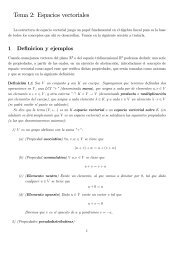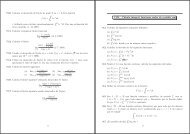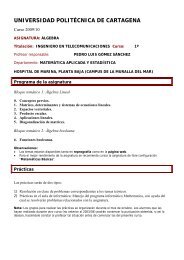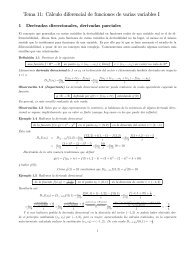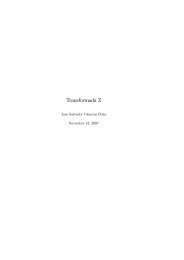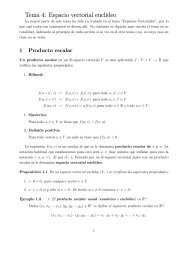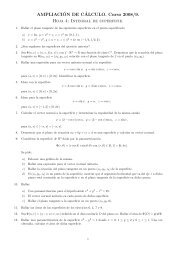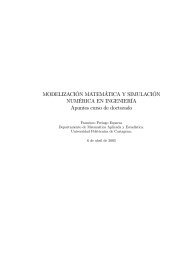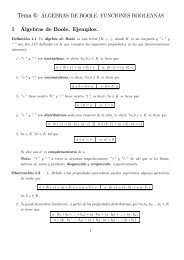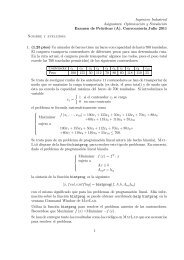Preprint (PDF) - Departamento de Matemática Aplicada y EstadÃstica ...
Preprint (PDF) - Departamento de Matemática Aplicada y EstadÃstica ...
Preprint (PDF) - Departamento de Matemática Aplicada y EstadÃstica ...
Create successful ePaper yourself
Turn your PDF publications into a flip-book with our unique Google optimized e-Paper software.
1 INTRODUCTION 3On the other hand, (P α ) has also been solved numerically by using a penalty and regularizationtechnique (see [7]). In this method, the cost function in (P α ) is replaced by12 ‖v‖2 L s (Ω) + 1 2 k ‖y (T )‖2 L 2 (Ω) ,where the penalty parameter k = k(α) is chosen large enough so that ‖y(T )‖ L2 (Ω) ≤ α holds. The use ofthe L s -norm (s large enough) instead of the L ∞ -norm avoids the problem of the non-differentiability ofthe L ∞ -norm and of any power of it. Numerical simulation results within this approach and for the caseof internal point-wise control are <strong>de</strong>scribed in [7].In this work we propose an alternative approach to solve numerically (P α ). Precisely, we take advantageof the bang-bang structure of the control and hence consi<strong>de</strong>r from the very beginning the controlsystem {yt − ∆y + ay = [λ1 O + (−λ)(1 − 1 O )]1 ω , (x, t) ∈ Q T(5)y(σ, t) = 0, (σ, t) ∈ Σ T , y(x, 0) = y 0 (x), x ∈ Ω.Notice that here, we impose a priori that the control v is of bang-bang type, that is, it takes only twovalues, λ on O ∩ q T and −λ on (Q\O) ∩ q T , respectively. λ is the amplitu<strong>de</strong> of the piecewise constantcontrol and O <strong>de</strong>pends on (x, t) but no volume constraint nor regularity assumption are introduced onO. Accordingly, for any α > 0, we consi<strong>de</strong>r the optimization problemwhere(BB α ){Minimize in (λ, 1 O ) : 1 2 λ2subject to (λ, 1 O ) ∈ D α (y 0 , T )D α (y 0 , T ) = {(λ, 1 O ) ∈ R + × L ∞ (q T ; {0, 1}) : y = y(λ, O) solves (5) and satisfies ‖y(T )‖ L 2 (Ω) ≤ α}.(7)Thus, (BB α ) can be viewed as an optimal <strong>de</strong>sign problem where we <strong>de</strong>sign the space-time regionwhere the control takes its two possible values and the optimality is related to the amplitu<strong>de</strong> of thebang-bang control. We would like to emphasize that this formulation makes sense and is of a practicalinterest even if the control of minimal L ∞ -norm is not of bang-bang type. In<strong>de</strong>ed, we address directlythe problem of computing bang-bang type controls with minimal amplitu<strong>de</strong> which, as indicated above, isof a major interest in practice. Up to our knowledge, this perspective has not been addressed so far.Since the space of admissible <strong>de</strong>signs is not convex, we first obtain a well-posed relaxed formulationand then show how this equivalent but new formulation allows to obtain, for any α > 0 arbitrarily small,a robust approximation of the solution of the original problem. Precisely, in Section 2 we introduce andanalyze this relaxed formulation (see Theorem 2.1). In particular, we obtain that the relaxed problemis an equivalent penalty version of (P α ) and prove that there exists a minimizing sequence of bang-bangtype controls (see Remark 1 and Theorem 2.1, part 3, for precise statements). Then, we <strong>de</strong>rive anddiscuss the first-or<strong>de</strong>r necessary optimality condition of the relaxed problem. From this, we recover thebang-bang structure of the control for the pure heat equation and in one space dimension.The case where the control acts on a part of the boundary in Dirichlet and Neumann forms is alsoconsi<strong>de</strong>red and the same type of results are obtained. The numerical resolution of the relaxed problemis addressed in Section 3. We <strong>de</strong>scribe the algorithm used to solve the relaxed problem and presentseveral numerical experiments. In particular, the approach allows to capture the oscillatory behavior ofthe control, as α goes to zero.(6)
2 RELAXATION AND NECESSARY OPTIMALITY CONDITIONS 42 Relaxation and necessary optimality conditions2.1 The inner caseWe adopt a penalty approach and for simplicity, we still use α to <strong>de</strong>note the penalty parameter. Hencewe transform (BB α ) into the following problem:⎧()Minimize in (λ, 1 O ) : J α (λ, 1 O ) = 1 2λ 2 + 1 α ‖y (T )‖2 L 2 (Ω)(T α )⎪⎨⎪⎩subject toy t − ∆y + ay = λ [(2 1 O − 1)] 1 ω , (x, t) ∈ Q T ,y (σ, t) = 0,(σ, t) ∈ Σ Ty (x, 0) = y 0 (x) ,x ∈ Ω(λ, 1 O ) ∈ R + × L ∞ (q T ; {0, 1}) .Accordingly, we also consi<strong>de</strong>r the problem⎧()Minimize in (λ, s) : J α (λ, s) = 1 2λ 2 + 1 α ‖y (T )‖2 L 2 (Ω)subject to⎪⎨(RT α )y t − ∆y + ay = [λ (2s (x, t) − 1)] 1 ω ,y (σ, t) = 0,y (x, 0) = y 0 (x)⎪⎩(λ, s) ∈ R + × L ∞ (q T ; [0, 1])(x, t) ∈ Q T(σ, t) ∈ Σ Tx ∈ ΩFrom now on we consi<strong>de</strong>r the space L ∞ (q T ; [0, 1]) endowed with the usual weak-⋆ topology. We thenhave the following result.Theorem 2.1 (RT α ) is a true relaxation of (T α ) in the following sense:1. there exists one minimizer of (RT α ) ,2. up to subsequences, every minimizing sequence, say (λ n , 1 On ) of (T α ) converges to some (λ, s) ∈R + × L ∞ (q T ; [0, 1]) such that (λ, s) is a minimizer for (RT α ) , and conversely,3. if (λ, s) is a minimizer for (RT α ) and if 1 On converges to s weak-⋆ in L ∞ (q T ; [0, 1]) , then, up to asubsequence, (λ, 1 On ) is a minimizing sequence for (T α ) .Proof. Let us first prove that the functional J α (λ, s) is continuous. Assume that (λ n , s n ) ∈ R + ×L ∞ (q T ; [0, 1]) satisfies{λn → λs n ⇀ s weak − ⋆ in L ∞ (q T ; [0, 1])as n → ∞.Since [λ n (2s n (x, t) − 1)] ⇀ [λ (2s (x, t) − 1)] weak-⋆ in L ∞ (q T ; [0, 1]) (in particular, also weakly inL 2 (q T )), the solution y n of the system⎧⎨⎩yt n − ∆y n + ay n = [λ n (2s n (x, t) − 1)] 1 ω ,y n (σ, t) = 0,y n (x, 0) = y 0 (x)satisfies { y n ⇀ y weakly in L 2 ( 0, T ; H 1 0 (Ω) )y n t ⇀ y t weakly in L 2 ( 0, T ; H −1 (Ω) ) ,(x, t) ∈ Q T(σ, t) ∈ Σ Tx ∈ Ω
2 RELAXATION AND NECESSARY OPTIMALITY CONDITIONS 5where y = y (x, t) solves⎧⎨⎩y t − ∆y + ay = [λ (2s (x, t) − 1)] 1 ω , (x, t) ∈ Q Ty (σ, t) = 0,(σ, t) ∈ Σ Ty (x, 0) = y 0 (x) x ∈ Ω.By Aubin’s lemma, up to a subsequence still labeled by n,Hence, up to a subsequence,y n → y strongly in L 2 ( 0, T ; L 2 (Ω) ) .y n (t, ·) → y (t, ·) strongly in L 2 (Ω) and a.e. t ∈ [0, T ] . (8)Since y n (t) are continuous functions, convergence (8) in fact holds for all t ∈ [0, T ]. In particular,J α (λ n , s n ) → J α (λ, s) as n → ∞.Moreover, J α (λ, s) is clearly coercitive. As a consequence, problem (RT α ) has a solution.Statements 2. and 3. are a straightforward consequence of the continuity of J α (λ, s) and of the<strong>de</strong>nsity of the space L ∞ (q T ; {0, 1}) in L ∞ (q T ; [0, 1]) .Remark 1 Notice that if we <strong>de</strong>note by v = λ (2s − 1) (so that λ = ‖v‖ L ∞), then the state law in problem(RT α ) equals the system (1). This way, (RT α ) is the penalty version of (P α ). Moreover, as a consequenceof the continuity of J α we conclu<strong>de</strong> that there exists a minimizing sequence of bang-bang type controls forthe penalty version of the approximate controllability problem (P α ).Next, we analyze the first-or<strong>de</strong>r necessary optimality condition for the relaxed problem (RT α ) .Theorem 2.2 The functional J α as <strong>de</strong>fined in problem ) (RT α ) is Gâteaux differentiable and its directional<strong>de</strong>rivative at (λ, s) in the admissible direction(̂λ, ŝ is given by∂J α (λ, s)∂(λ, s)( ∫) ∫· (ˆλ, ŝ) = ˆλ λ − p(2s − 1) dx dt − 2λ pŝ dxdt (9)q T q Twhere p ∈ C ( [0, T ] ; L 2 (Ω) ) ∩ L 2 ( 0, T ; H 1 0 (Ω) ) solves the adjoint equationProof.{− pt − ∆p + ap = 0, (x, t) ∈ Q Tp(σ, t) = 0, (σ, t) ∈ Σ T , p(x, T ) + α −1 y(x, T ) = 0, x ∈ Ω.)()Let(̂λ, ŝ ∈ R + ×L ∞ (q T ; [0, 1]) be an admissible direction, i.e., for ε small enough, λ + ε̂λ, s + εŝ ∈R + × L ∞ (q T ; [0, 1]) . Denote by y (λ+ε̂λ,s+εŝ)the solution of the state law as <strong>de</strong>fined in (RT α ) associated()with the perturbation λ + ε̂λ, s + εŝ . Thanks to the linearity of the heat equation it is easy to see thaty (λ+ε̂λ,s+εŝ)= y (λ,s) + εŷ + ε 2 ỹ(10)where y (λ,s) is the state associated with the control (λ, s) , ŷ is a solution to⎧[⎨ ŷ t − ∆ŷ + aŷ = 2 λŝ + ̂λ](s − 1) 1 ω , (x, t) ∈ Q T⎩ŷ (σ, t) = 0 (σ, t) ∈ Σ T , ŷ (x, 0) = 0 x ∈ Ω,(11)
and ỹ solves {ỹt − ∆ỹ + aỹ = ̂λŝ1 ω , (x, t) ∈ Q T2 RELAXATION AND NECESSARY OPTIMALITY CONDITIONS 6A straightforward computation shows that∂J α (λ, s)∂(λ, s)ỹ(σ, t) = 0, (σ, t) ∈ Σ T , ỹ (x, 0) = 0 x ∈ Ω.()J α λ + ε̂λ, s + εŝ· (ˆλ, ŝ) = limε→0 ε− J α (λ, s)= λ̂λ + 1 ∫αΩy (λ,s) (T ) ŷ (T ) dx. (12)On the other hand, taking into account the initial condition ŷ (0) = 0 and the final condition p (T ) =−α −1 y (T ) , from the weak form of the system (11) it is <strong>de</strong>duced that∫∫∫1y (λ,s) (T ) ŷ (T ) dx = −̂λ (2s − 1) dxdt − 2λ pŝdxdtα Ωq T q Tfor p ∈ W (0, T ) = { v ∈ L ( 2 0, T ; H0 1 (Ω) ) : v t ∈ L ( 2 0, T ; H −1 (Ω) )} solution of (10).expression into (12) we obtain (9).Replacing thisCorollary 2.1 Let (λ ⋆ , s ⋆ ) ∈ R + × L ∞ (q T ; [0, 1]) be an optimal solution of (RT α ). Then s ⋆ takes theform{ 0 if p (x, t) < 0s ⋆ (x, t) =(13)1 if p (x, t) > 0and λ ⋆ = ‖p‖ L 1 (q T ). Consequently, if N = 1 or if the potential a = 0 for N > 1, then s⋆ is a characteristicfunction and therefore problem (T α ) is well-posed, i.e., the control is of bang-bang type.Proof.Let (λ ⋆ , s ⋆ ) ∈ R + × L ∞ (q T ; [0, 1]) be an optimal solution of (RT α ). From (9) it follows that( ∫) ∫(λ − λ ⋆ ) λ ⋆ − p(2s ⋆ − 1) dx dt − 2λ ⋆ p(s − s ⋆ ) dxdt ≥ 0 (14)q T q Tfor all (λ, s) ∈ R + × L ∞ (q T ; [0, 1]) . In particular, if λ = λ ⋆ , then∫∫ps ⋆ dxdt ≥ psdxdt ∀s ∈ L ∞ (q T ; [0, 1]) .q T qAn standard localization argument (see for instance [15, pages 67-69]) shows that this variational inequalityis equivalent to the point-wise variational inequalityp (x, t) s ⋆ (x, t) ≥ p (x, t) s (x, t) ∀s ∈ L ∞ (q T ; [0, 1]) , for a.e. (x, t) ∈ q T .From this we easily obtain (13).Now consi<strong>de</strong>r the case of the pure heat equation, i.e., a = 0. Using the fact that thanks to theanalyticity of p the zero set of p has zero Lebesgue measure, we conclu<strong>de</strong> that s ⋆ is a characteristicfunction. The same holds if a ≠ 0 and N = 1 (see [2]).Finally, if we put s = s ⋆ in (14), then∫λ ⋆ = p (2s ⋆ − 1) dxdt = ‖p‖ L1 (q T ) ,q Twhere the last equality is a consequence of (13). Remark that from this last equality and (13), the optimalcontrol λ ⋆ (2s ⋆ − 1) has exactly the structure given by (3).Remark 2 Notice that even in the case where (T α ) is well-posed, the relaxed formulation (RT α ) is notuseless. In<strong>de</strong>ed, at the numerical level, since the admissibility set for (RT α ) is convex (contrary to whathappens in (T α )), it is allowed to make variations in this space and therefore we may implement a<strong>de</strong>scent algorithm to solve (RT α ), and consequently also (T α ). Moreover, Theorem 2.1, part 3, provi<strong>de</strong>sa constructive way of computing a minimizing sequence of bang-bang type controls for the general case ofthe heat equation with a potential in dimension N > 1.
2 RELAXATION AND NECESSARY OPTIMALITY CONDITIONS 72.2 The boundary caseIn this section we address the situation in which the control acts on a part of the boundary. We consi<strong>de</strong>rboth the cases of Dirichlet and Neumann type controls.2.2.1 Dirichlet-type controlsFor a fixed α > 0, we focus on the control system⎧⎨ y t − ∆y + ay = 0,y (σ, t) = f (σ, t) 1⎩Σ0y (x, 0) = y 0 (x)(x, t) ∈ Q T(σ, t) ∈ Σ Tx ∈ Ω(15)and look for the control f, with support in Σ 0 = Γ 0 × (0, T ), which satisfies‖y (T )‖ H −1 (Ω)≤ α. (16)It is important to notice that we have moved from the L 2 −norm for the final state to the H −1 −normbecause, as noticed in ([10, p. 217]), if we take f ∈ L 2 (Σ 0 ) and y 0 ∈ L 2 (Ω), then, in general, we do nothave y (T ) ∈ L 2 (Ω) .Un<strong>de</strong>r some technical assumptions, some positive results concerning the existence of a solution for theapproximate controllability problem (15)-(16) are obtained in [5].Similarly to the inner situation, we consi<strong>de</strong>r the optimization problem⎧()Minimize in (λ, 1 O ) : J α (λ, 1 O ) = 1 2λ 2 + 1 α ‖y (T )‖2 H −1 (Ω)(B α )⎪⎨⎪⎩subject toy t − ∆y + ay = 0,y (σ, t) = λ [2 1 O − 1] 1 Σ0y (x, 0) = y 0 (x) ,(λ, 1 O ) ∈ R + × L ∞ (Σ 0 ; {0, 1})(x, t) ∈ Q T(σ, t) ∈ Σ Tx ∈ Ωwith y 0 ∈ L 2 (Ω) .We also consi<strong>de</strong>r the new problem⎧()Minimize in (λ, s) : J α (λ, s) = 1 2λ 2 + 1 α ‖y (T )‖2 H −1 (Ω)subject to⎪⎨(RB α )y t − ∆y + ay = 0,y (σ, t) = λ [2s (σ, t) − 1] 1 Σ0y (x, 0) = y 0 (x) ,⎪⎩(λ, s) ∈ R + × L ∞ (Σ 0 ; [0, 1]) .(x, t) ∈ Q T(σ, t) ∈ Σ Tx ∈ ΩThen, we have:Theorem 2.3 (RB α ) is a relaxation of (B α ) in the same terms as stated in Theorem 2.1.Before proving this result, we recall some results concerning the properties of the solution to thefollowing non-homogeneous system:⎧⎨ y t − ∆y + ay = 0, (x, t) ∈ Q Ty (σ, t) = f (σ, t) (σ, t) ∈ Σ⎩T(17)y (x, 0) = y 0 (x) x ∈ Ω,with f ∈ L ∞ (Σ T ) and y 0 ∈ L 2 (Ω) .
2 RELAXATION AND NECESSARY OPTIMALITY CONDITIONS 8Following [10, pp. 208-221] or [11, Vol. II, p.86], a weak solution of (17) is a function y ∈ L 2 (Q T )which satisfies ∫∫∫y(−ϕ t − ∆ϕ + aϕ)dxdt = y 0 (x)ϕ(x, 0)dx − f∂ ν ϕdΣ TQ T ΩΣ Tfor all ϕ ∈ X 1 (Q T ) = { v ∈ H 2,1 (Q T ) : v = 0 on Σ T and v (x, T ) = 0, x ∈ Ω } . As usual, ∂ ν ϕ <strong>de</strong>notesthe directional <strong>de</strong>rivative of ϕ in the direction of the outward unit normal vector to Γ. Then, itis proved (see also [5, Prop. 5.1]) that there exists a unique weak solution of system (17) which has theregularity( )y ∈ H 1/2,1/4 (Q T ) = L 2 0, T ; H 1/2 (Ω) ∩ H 1/4 ( 0, T ; L 2 (Ω) ) .Moreover, the estimate‖y‖ H 1/2,1/4 (Q T ) ≤ c (‖f‖ L∞ (Σ T ) + ‖y 0‖ L2 (Ω))holds. In particular,)‖y‖ L2 (0,T ;L 2 (Ω))(‖f‖ ≤ c L∞ (Σ T ) + ‖y 0‖ L 2 (Ω). (18)On the other hand, standard arguments show that the weak solution of (17) also satisfies y t ∈ L ( 2 0, T ; H −2 (Ω) )and)‖y t ‖ L2 (0,T ;H −2 (Ω))(‖f‖ ≤ c L∞ (Σ T ) + ‖y 0‖ L2 (Ω). (19)Finally, we also notice that y ∈ C ( [0, T ] ; H −1 (Ω) ) , see [11, Vol. I, Th. 3.1]. As a consequence, the costfunctionals J α and J α above are well-<strong>de</strong>fined.Proof of Theorem 2.3. The proof follows the same lines as in Theorem 2.1 so that we only indicate themain differences. To prove the continuity of J α , let us take (λ n , s n ) ∈ R + × L ∞ (Σ 0 ; [0, 1]) such that{λn → λs n ⇀ s weak − ⋆ in L ∞ (Σ 0 ; [0, 1]) .From estimates (18) and (19) it follows that the corresponding weak solution of⎧⎨ yt n − ∆y n + ay n = 0,(x, t) ∈ Q Ty⎩n (σ, t) = λ n (2s n (σ, t) − 1) 1 Σ0 (σ, t) ∈ Σ Ty n (x, 0) = y 0 (x) x ∈ Ω,satisfies { y n ⇀ y weakly in L 2 ( 0, T ; L 2 (Ω) )where y = y (x, t) solves⎧⎨⎩y n t ⇀ y t weakly in L 2 ( 0, T ; H −2 (Ω) ) ,y t − ∆y + ay = 0,(x, t) ∈ Q Ty (σ, t) = λ (2s (σ, t) − 1) 1 Σ0 (σ, t) ∈ Σ Ty (x, 0) = y 0 (x) x ∈ Ω.Again by Aubin’s lemma, up to a subsequencey n → y strongly in L 2 ( 0, T ; H −1 (Ω) ) .Hence, as in the inner case, we haveJ α (λ n , s n ) → J α (λ, s) as n → ∞.The rest of the proof runs as in Theorem 2.1.
2 RELAXATION AND NECESSARY OPTIMALITY CONDITIONS 9Remark 3 We notice that if the initial condition y 0 ∈ L ∞ (Ω) , then the solution of system (17) satisfiesy ∈ L ∞ (Q T ) (see [10, p.221]). In particular, y (T ) ∈ L 2 (Ω) and therefore the H −1 (Ω) −norm in thecosts J α and J α may be replaced by the L 2 (Ω) −norm.From now on, we assume that y 0 belongs to L ∞ (Ω) and then replace in J α and J α the termα −1 ‖y(T )‖ 2 H −1 (Ω) by α−1 ‖y(T )‖ 2 L 2 (Ω). Similarly to Theorem 2.2 and Corollary 2.1 we have:Theorem 2.4 For y 0 ∈ L ∞ (Ω) the functional J α as <strong>de</strong>fined)above is Gâteaux differentiable and itsdirectional <strong>de</strong>rivative at (λ, s) in the admissible direction(̂λ, ŝ is given by∂J α (λ, s)∂(λ, s)where p solves the backward equation (10).() ∫· (ˆλ, ŝ) = ˆλ λ + ∂ ν p(2s − 1) dΣ 0 + 2λ ∂ ν pŝ dΣ 0 (20)∫Σ 0 Σ 0Corollary 2.2 Let (λ ⋆ , s ⋆ ) ∈ R + × L ∞ (Σ 0 ; [0, 1]) be an optimal solution of (RB α ). Then s ⋆ takes theform{ 0 ifs ⋆ ∂ν p (σ, t) < 0(σ, t) =(21)1 if ∂ ν p (σ, t) > 0and λ ⋆ = ‖∂ ν p‖ L 1 (Σ 0).As a consequence, if N = 1 or if the potential a = 0 for N > 1, then s ⋆ is acharacteristic function and therefore problem (B α ) is well-posed, i.e., the control is of bang-bang type.2.2.2 Neumann-type controlsConsi<strong>de</strong>r the system⎧⎨⎩y t − ∆y + ay = 0 in Q T∂ ν y = g on Σ Ty (0) = y 0 in Ω.It is well-known (see for instance [11] or [15]) that for y 0 ∈ L 2 (Ω) and g ∈ L ( 2 0, T ; H −1/2 (Γ) ) thesystem (22) has a unique solution y ∈ L ( 2 0, T ; H 1 (Ω) ) ∩ C ( [0, T ] ; L 2 (Ω) ) which satisfies the variationalformulation∫∫dy (x, t) v (x) dx + [∇y (x, t) ∇v (x) + a (x, t) y (x, t) v (x)] dx = < g (t) , v > Γ ∀v ∈ H 1 (Ω) ,dtΩΩwhere < ·, · > Γ stands for the duality product in H 1/2 (Γ) . Moreover,()‖y‖ C([0,T ];L 2 (Ω)) + ‖y‖ L 2 (0,T ;H 1 (Ω)) ≤ C ‖y 0 ‖ L 2 (Ω) + ‖g‖ L 2 (0,T ;H −1/2 (Γ)).andWith the same notation as in the preceding section, we consi<strong>de</strong>r the two problems⎧()Minimize in (λ, 1 O ) : J α (λ, 1 O ) = 1 2λ 2 + 1 α ‖y (T )‖2 L 2 (Ω)(NB α )(RNB α )⎪⎨⎪⎩⎧⎪⎨⎪⎩subject toMinimize in (λ, s) : J α (λ, 1 O ) = 1 2subject toy t − ∆y + ay = 0 in Q T∂ ν y (σ, t) = λ [21 O (σ, t) − 1] 1 Σ0 on Σ Ty (0) = y 0 in Ω(λ, 1 O ) ∈ R + × L ∞ (Σ T ; {0, 1})()λ 2 + 1 α ‖y (T )‖2 L 2 (Ω)y t − ∆y + ay = 0 in Q T∂ ν y (σ, t) = λ [2s (σ, t) − 1] 1 Σ0 on Σ Ty (0) = y 0 in Ω(λ, s) ∈ R + × L ∞ (Σ T ; [0, 1]) .(22)
3 ALGORITHM - NUMERICAL EXPERIMENTS 10The same type of arguments as the ones used in the two preceding cases lets prove that (RNB α ) is arelaxation of (NB α ). Also, a direct computation shows that the functional ) J α is Gâteaux differentiableand its directional <strong>de</strong>rivative at (λ, s) in the admissible direction(̂λ, ŝ is given by∂J α (λ, s)∂ (λ, s)where p solves the system) () ∫·(̂λ, ŝ = ̂λ λ + p (2s − 1) dΣ 0 + 2λ ŝpdΣ, (23)∫Σ 0 Σ 0⎧⎨⎩−p t − ∆p + ap = 0 in Q T∂ ν p = 0 on Σ T(24)p (T ) = 1 α y (T ) in Ω.By using (23), it is not hard to show that if (λ ⋆ , s ⋆ ) is a solution of (RNB α ), then{ 0 if p (σ, t) > 0s ⋆ (σ, t) =1 if p (σ, t) < 0and λ ⋆ = ‖p‖ L 1 (Σ 0)3 Algorithm - Numerical experiments3.1 Algorithm and numerical approximationLet us provi<strong>de</strong> some <strong>de</strong>tails on the inner situation and in the one dimensional space case. From now on,we take Ω = (0, 1).First notice that we may remove the constraint λ ∈ R + since, if (λ, s) solves (RT α ), then (−λ, 1 − s)is also a solution. Hence, the expression (9) provi<strong>de</strong>s the following iterative <strong>de</strong>scent algorithm :⎧(λ 0 , s 0 ) ∈ R × L ∞ (Q T , [0, 1]),⎪⎨∫)λ n+1 = λ n − a n(λ n − p n (2s n − 1) dx dt , n ≥ 0,(25)q T⎪⎩s n+1 = P [0,1] (s n + b n λ n p n ), n ≥ 0where p n solves (10), P [0,1] (x) = max(0, min(1, x)) <strong>de</strong>notes the projection of any x onto [0, 1] and a n , b n<strong>de</strong>note the optimal <strong>de</strong>scent step which is obtained as the solution of the extremal problem :min J α (λ n+1 (a), s n+1 (b)) over a, b ∈ R + . (26)Problem (26) is solved by using line search techniques. The gradient algorithm is stopped as soon as∫|λ n − p n (2s n − 1)dxdt| ≤ σ (27)q Tfor some given tolerance σ > 0 small enough. In the sequel, σ := 10 −3 .As for the numerical discretization, we use the two-step Gear scheme (of second or<strong>de</strong>r) for the timeintegration coupled with a P 1 finite element approach for the spatial approximation. Precisely, for largeinteger N x , we consi<strong>de</strong>r the N x points x i ∈ [0, 1] such that x 1 = 0, x i < x i+1 and x Nx = 1. We notefor i ∈ {1, N x − 1}, ∆x i = x i+1 − x i and ∆x = max ∆x i . We note by P ∆x the corresponding partitionof Ω = [0, 1] and by P ∆t the corresponding partition of [0, T ], obtained in the same way. Finally, seth = (∆x, ∆x) and Q h the quadrangulation of Q T associated to h so that in particular Q T = ⋃ K∈Q hK.The following (conformal) finite element approximation of L 2 (0, T ; H0 1 (0, 1)) is introduced:X 0h = { ϕ h ∈ C 0 (Q T ) : ϕ h | K ∈ (P 1,x ⊗ P 1,t )(K) ∀K ∈ Q h , ϕ h (0, t) = ϕ h (1, t) = 0 ∀t ∈ (0, T ) }.
3 ALGORITHM - NUMERICAL EXPERIMENTS 11Here P m,ξ <strong>de</strong>notes the space of polynomial functions of or<strong>de</strong>r m in the variable ξ. Accordingly, thefunctions in X 0h reduce on each quadrangle K ∈ Q h to a linear polynomial in both x and t. The spaceX 0h , conformal approximation of L 2 (Q T ) is a finite-dimensional subspace of L 2 (0, T ; H 1 0 (0, 1)). Moreover,the functions ϕ h ∈ X 0h are uniquely <strong>de</strong>termined by their values at the no<strong>de</strong>s (x i , t j ) of Q h such that0 < x i < 1.Let us now introduce other finite dimensional spaces. First, we setΦ ∆x = { z ∈ C 0 ([0, 1]) : z| k ∈ P 1,x (k) ∀k ∈ P ∆x }.Then, Φ ∆x is a finite dimensional subspace of L 2 (0, 1) and the functions in Φ ∆x are uniquely <strong>de</strong>terminedby their values at the no<strong>de</strong>s of P ∆x .Secondly, since the variable λ(2s−1) ∈ L ∞ (Q T ) appears in the right hand si<strong>de</strong> of the forward problemin y, it is natural to approximate λ(2s − 1) ∈ L ∞ (Q T ) by a piecewise constant function. Thus, let M hbe the space <strong>de</strong>fined byM h = { µ h ∈ L ∞ (Q T ) : µ h | K ∈ (P 0,x ⊗ P 0,t )(K) ∀K ∈ Q h }.M h is a finite dimensional subspace of L ∞ (Q T ) and the functions in M h are uniquely <strong>de</strong>termined by their(constant) values on the quadrangles K ∈ Q h .Therefore, for any s h ∈ M h and any λ h ∈ R, the approximation y h ∈ X 0h of the solution of (RT α ) isgiven as follows :(i) Consi<strong>de</strong>r the times t j = j∆t and set y h | t=0 = π ∆x (y 0 ) ∈ Φ ∆x .(ii) Then, y h | t=t1 is the solution to the linear problem⎧ ∫ 110 ∆t (Ψ − y h| t=0 )z dx + 1 ∫ 1(Ψ x z x + π ∆x A(x, t 1 )Ψz) dx2 0⎪⎨+ 1 ∫ 1((y h | t=0 ) x z x + π ∆x A(x, t Nt )y h | t=0 z) dx2⎪⎩= 1 2 λ h0∫ 10((2s h (x, t 1 ) − 1) + (2s h (x, t 0 ) − 1)z(x) dx ∀z ∈ Φ ∆x , Ψ ∈ Φ ∆x .(iii) Finally, for given n = 1, . . . , N − 1, Ψ ⋆ = y h | t=tn−1 and Ψ = y h | t=tn , y h | t=tn+1 is the solution to thelinear problem⎧ ∫ 1⎪ 1 ⎨2∆t (3Ψ − 4Ψ + Ψ⋆ )z dx +⎪ ⎩0=∫ 10∫ 10(Ψ x z x + π ∆x (A(x, t n−1 ))Ψz) dxµ h (x, t n−1 )z(x) dx ∀z ∈ Φ ∆x , Ψ ∈ Φ ∆x .Here, π ∆x <strong>de</strong>notes the projection over Φ ∆x .We are thus using the two-step implicit Gear algorithm as a numerical tool to solve numerically theproblem (RT α ). As advocated in [4], where the influence of the time discretization is highlighted, ithas been observed that this second or<strong>de</strong>r scheme ensures a better behavior of the un<strong>de</strong>rlying gradientalgorithm than, for instance, the implicit Euler scheme. At the finite dimensional level, algorithm (25)reads as follows :⎧(λ 0 h, s 0 h) ∈ R × M h ,⎪⎨∫)λ n+1h= λ n h − a nh(λ n h − p n h(2s n h − 1) dx dt , n ≥ 0,(28)q T⎪⎩s n+1h= P [0,1] (s n h + b nh λ n hp n h), n ≥ 0where p n h is an approximation of the backward problem (10), obtained by using P 1 finite element in spaceand the Gear scheme for the time integration, as <strong>de</strong>scribed above.
3 ALGORITHM - NUMERICAL EXPERIMENTS 123.2 Numerical experiments3.2.1 Distributed caseWe now provi<strong>de</strong> some numerical results in the one dimensional space case and discuss mainly the influenceof the penalty parameter α. We take Ω = (0, 1) and first consi<strong>de</strong>r the data ω = (0.25, 0.75), a ≡ 0 andy 0 (x) = sin(2πx). In or<strong>de</strong>r to have a better control of the diffusion, we also replace the operator −∆ by−c∆ with c lower than one. This does not modify the theoretical part.The <strong>de</strong>scent algorithm is initialized with λ = 1 and s = 1/2 over Q T . We take σ := 10 −3 as stoppingcriterion parameter.We take a uniform partition P ∆x for Ω : x i+1 − x i = 1/N x with N x = 400. On the other hand, inor<strong>de</strong>r to <strong>de</strong>scribe correctly the oscillations of the <strong>de</strong>nsity near T , we take a non uniform partition P ∆t ofthe time interval (0, T ): precisely we <strong>de</strong>finet 1 = 0; t j+1 − t j =T pTe pT (eN t− 1− 1)e p(N t +1−j)N T tj = 1, ..., N twhere N t ∈ N is the number of sub-interval of the partition P ∆t and any p ∈ N. The points t j , distributedalong (0, T ), are thus exponentially concentrated near T . This property is amplified for increasing valuesof p. Here p := 6 and N t = 400.Table 1 collects the value of λ h and ‖y h (·, T )‖ L 2 (0,1) with respect to the penalty parameter α. Wetake c := 1/10.We check that the L ∞ -norm λ h of the control increases as α goes to zero : in other words, the amountof work nee<strong>de</strong>d to get closer to the zero target at time T is more important. However, as a consequenceof the null controllability of (1) with v ∈ L ∞ (q T ), we check that λ h is uniformly boun<strong>de</strong>d by above withrespect to α.The value α also affects the shape of the bang-bang control. Figure 1 <strong>de</strong>picts the iso-values of theoptimal <strong>de</strong>nsity for α = 10 −2 , 10 −4 , 10 −6 and α = 10 −8 . According to the symmetry of ω and of theinitial datum y 0 , we obtain symmetric <strong>de</strong>nsity over Q T . For α = 10 −2 , the <strong>de</strong>nsity is constant in timeand related to the sign of y 0 : precisely, for all t, s h (x, t) = 0 if y 0 (x) > 0 and s h (x, t) = 1 if y 0 (x) < 0.However, for α small enough, for instance here, α = 10 −3 , the optimal <strong>de</strong>nsity exhibits some variationswith respect to the variable t. These variations are mainly located at the end of the time interval.Moreover, as α <strong>de</strong>creases, the number of theses oscillations, that is, the number of theses changes of signof v h increases so that, at the null controllability limit (α = 0) one may expected an oscillatory behaviorof the bang-bang control both in space and time, in an arbitrarily close neighborhood of (0, 1) × {T }.This is in agreement with our observations in the L 2 case (see [14]). Of course, as in the L 2 -case, thisbehavior may only be captured with an arbitrarily finer mesh. The increasing number of iterates nee<strong>de</strong>dto satisfy the criterion (27) as α <strong>de</strong>creases is also a consequence of these oscillations near T .In Figure 1 we also observe that (except for α = 10 −2 ) the optimal <strong>de</strong>nsity s h is not strictly a bivalued0 − 1 (as it should be almost everywhere) and takes some intermediate values: this is only dueto the numerical approximation and to the very low variation of the cost function with respect to the<strong>de</strong>nsity near the minimum (a bi-valued <strong>de</strong>nsity is obtained after a very large number of iterates). Figure2 displays the sign of the adjoint solution p (see 10) in q T and also clearly exhibits the variation of thebang-bang control: recall that from (13), s and p are related through the relation 2s − 1 = sign(p).More interesting is the fact that, whatever be the initial value (λ 0 h , s0 h ) ∈ R+ × L ∞ (Q T , [0, 1]) guesswe consi<strong>de</strong>r as the starting point for the algorithm, we always get the same limit. This is of course inagreement with the fact the control v of minimal L ∞ -norm is unique, and so the couple (λ, s) <strong>de</strong>fined byv = λ(2s − 1)1 ω is.We now consi<strong>de</strong>r both a boun<strong>de</strong>d but discontinuous potential a and a discontinuous initial datum.Precisely, for Ω = (0, 1) and ω = (0.2, 0.6), we take
3 ALGORITHM - NUMERICAL EXPERIMENTS 13α 10 −1 10 −2 10 −4 10 −6 10 −8‖y h (T )‖ L 2 (Ω) 8.96 × 10 −2 5.34 × 10 −2 6.24 × 10 −3 4.37 × 10 −4 9.17 × 10 −5λ h 0.087 0.471 1.309 1.831 1.948♯ iterates 11 213 561 1032 4501Table 1: N x = N t = 400 - y 0 (x) = sin(2πx) - c = 0.111110.90.90.90.90.80.80.80.80.70.70.70.70.60.60.60.6x0.50.5x0.50.50.40.40.40.40.30.30.30.30.20.20.20.20.10.10.10.100 0.1 0.2 0.3 0.4 0.5t000 0.1 0.2 0.3 0.4 0.5t011110.90.90.90.90.80.80.80.80.70.70.70.70.60.60.60.6x0.50.5x0.50.50.40.40.40.40.30.30.30.30.20.20.20.20.10.10.10.100 0.1 0.2 0.3 0.4 0.5t000 0.1 0.2 0.3 0.4 0.5t0Figure 1: N x = N t = 400 - y 0 (x) = sin(2πx) - ω = (0.25, 0.75) - c = 0.1 - From left to right and from topto button, iso-values of the <strong>de</strong>nsity function s h in Q T for α = 10 −2 , 10 −4 , 10 −6 and α = 10 −8 .
3 ALGORITHM - NUMERICAL EXPERIMENTS 1411110.90.80.90.80.80.60.80.60.70.40.70.40.60.20.60.2x0.50x0.500.40.20.40.20.30.40.30.40.20.60.20.60.10.80.10.800 0.1 0.2 0.3 0.4 0.5t100 0.1 0.2 0.3 0.4 0.5t1Figure 2: N x = N t = 400 - y 0 (x) = sin(2πx) - ω = (0.25, 0.75) - c = 0.1 - Sign of the adjoint state p forα = 10 −6 (left) and α = 10 −8 (right).a (x) ={ 1, 0 ≤ x ≤ 0.5{ 0, x ∈ [0, 0.1] ∪ [0.9, 1]−3, 0.5 < x ≤ 1 , y 0 (x) =1., 0.1 < x < 0.9.(29)The over data remain unchanged. For α = 10 −6 , Figure 3 <strong>de</strong>picts the iso-values of the optimal<strong>de</strong>nsity s h together with the sign of the corresponding adjoint solution p over Q T . The convergence leadsto λ h ≈ 14.35 for which ‖y h (T )‖ L 2 (0,1) ≈ 4.11 × 10 −6 . Here, of course, the symmetry of the <strong>de</strong>nsity islost. As in the preceding test, we observe variations of the <strong>de</strong>nsity near T , up to the error due to thenumerical approximation.11110.90.90.90.80.80.80.80.60.70.70.70.40.60.60.60.2x0.50.5x0.500.40.40.40.20.30.30.30.40.20.20.20.60.10.10.10.800 0.1 0.2 0.3 0.4 0.5t000 0.1 0.2 0.3 0.4 0.5t1Figure 3: Nx = 400 - N t = 400 - ω = (0.2, 0.6) - α = 10 −6 - Discontinuous data as in (29)- Iso-values ofthe <strong>de</strong>nsity function s h in Q T (left) and sign of p (right).
3 ALGORITHM - NUMERICAL EXPERIMENTS 153.2.2 Boundary caseIn the boundary situation, the <strong>de</strong>nsity s is simply a time function. This allows to observe clearer thehigh singular character of the bang-bang control as α goes to zero, that is, when one wants to recoverthe null control of minimal L ∞ -norm. The procedure is very similar, except that we also consi<strong>de</strong>r a nonuniform partition P ∆x (concentrated on x = 1) in or<strong>de</strong>r to better <strong>de</strong>scribe the final state p(T ) of theadjoint system (oscillating near x = 1).x 1 = 0; x i+1 − x i = 1e p − 1 (e pNx − 1)e p(Nx+1−i)Nx i = 1, ..., N x .with here p := 3 and still N x = 400.The minimization procedure is similar. For the Dirichlet boundary control consi<strong>de</strong>red in Section 2.2.1,fromTheorem 2.4, we may consi<strong>de</strong>r the following <strong>de</strong>scent algorithm.⎧(λ 0 h, s 0 h) ∈ R × N h ,⎪⎨λ n+1h= λ n h − a nh(λ n h +⎪⎩∫Σ 0∂ ν p n h(2s n h − 1) dΣ 0), n ≥ 0,s n+1h= P [0,1] (s n h − b nh λ n h∂ ν p n h(1, ·)), n ≥ 0where p n h is as above an approximation of the backward problem (10) and N h the space <strong>de</strong>fined byN h = { µ h ∈ L ∞ ([0, T ]) : µ h | k ∈ P 0,t )(K) ∀k ∈ P ∆t }.As in the inner situation, the residue∫∣ ∣∣∣∣ λn h + ∂ ν p n h(2s n h − 1) dΣ 0Σ 0is used as stopping criterion for the algorithm. For the Neumann boundary control discussed in Section2.2.2, the algorithm is given by⎧(λ 0 h, s 0 h) ∈ R × N h ,⎪⎨λ n+1h= λ n h − a nh(λ n h +⎪⎩∫Σ 0p n h(2s n h − 1) dΣ 0), n ≥ 0,s n+1h= P [0,1] (s n h + b nh λ n hp n h(1, ·)), n ≥ 0(30)(31)where p n his an approximation of the solution p of (24).Let us discuss the Neumann boundary case. We take y 0 (x) = sin(πx), T = 1/2, c = 1/10, a := 0.The stopping criterion is related to the absolute value |λ − ∫ 1p(1, t) (2s − 1) dt|. We stop the algorithm0as soon as this value is lower than 10 −3 . Table 2 reports the L ∞ -norm λ h and the L 2 (0, 1)-norm of y h (T )for various values of the penalty parameter α. The amplitu<strong>de</strong> λ h of the bang-bang control increases asα → 0, and is significantly bigger than in the inner case. This is due to the fact that the control actsonly on a single point of Ω.α 10 −2 10 −4 10 −6 10 −8‖y h (·, T )‖ L2 (Ω) 2.96 × 10 −1 1.59 × 10 −1 5.56 × 10 −2 9.31 × 10 −3λ h 1.488 10.181 29.121 34.03♯ iterates 33 512 6944 20122Table 2: (λ h , y h (T )) with respect to α in the Neumann boundary case.
3 ALGORITHM - NUMERICAL EXPERIMENTS 16Figure 4 <strong>de</strong>picts the optimal <strong>de</strong>nsity s h with respect to the time variable. We observe here that the<strong>de</strong>nsity is almost everywhere a characteristic function with an increasing number of change of sign as tgoes to T − . Figure 5 <strong>de</strong>picts the trace, both in time and space, of the approximate controlled solutiony h while Figure 6 displays y h along Q T .Let us insist again on that oscillatory behavior and display the <strong>de</strong>nsity for α = 10 −6 . Figures 7, 8and 9 <strong>de</strong>pict the optimal <strong>de</strong>nsity s h (t) for t ∈ [0., 0.5], t ∈ [0.4, 0.5] and t ∈ [0.48, 0.5] respectively. Thesefigures indicates that the frequency of these sign changes increases as t is close to T . Moreover, thenumber of these sign’ changes increases as α → 0. In spite of this singular phenomenon, we observe againthe invariance of the limit (λ h , s h ) of the algorithm with respect to the initialization, consequence of theuniqueness of the minimal L ∞ - norm control.At the limit in α → 0, we expect a boun<strong>de</strong>d amplitu<strong>de</strong> λ h but an arbitrarily large number of oscillationsnear T , in full agreement with our observations for the L 2 situation in [14]. The figures also confirm,in agreement with the optimality conditions for J α that, the optimal <strong>de</strong>nsity is almost everywhere acharacteristic function, so that no relaxation is nee<strong>de</strong>d. The only point where the <strong>de</strong>nsity is not 0 or 1 isat the final time: From Figure 9, s h (T ) is close to 1/2, intermediate value which reinforces the property,that at the limit in α, the null control highly oscillates at t = T − .110.80.80.60.60.40.40.20.2000 0.1 0.2 0.3 0.4 0.5t0.38 0.4 0.42 0.44 0.46 0.48 0.5tFigure 4: Neumann case - The optimal <strong>de</strong>nsity s h (t) for t ∈ [0, T ] - α = 10 −4 .For Dirichlet boundary control, the situation is very similar: we simply report here in Table 3 theoptimal couple (λ h , ‖y h (T )‖ L2 (0,1)) with respect to α.α 10 −2 10 −4 10 −6 10 −8‖y h (·, T )‖ L 2 (Ω) 9.21 × 10 −2 3.28 × 10 −3 7.31 × 10 −4 2.34 × 10 −5λ h 0.98 5.12 7.30 9.02♯ iterates 21 319 4912 9301Table 3: (λ h , ‖y h (T )‖ L2 (0,1)) with respect to α in the Dirichlet boundary case.
3 ALGORITHM - NUMERICAL EXPERIMENTS 171050510150 0.1 0.2 0.3 0.4 0.5t0.30.250.20.150.10.0500.050.10 0.2 0.4 0.6 0.8 1xFigure 5: Neumann case - Left : y h (1, t) for t ∈ (0, T ) ; Right: y h (x, T ) for x ∈ (0, 1) - α = 10 −4 .Figure 6: Neumann case - Approximated controlled solution y h over Q T
3 ALGORITHM - NUMERICAL EXPERIMENTS 1810.80.60.40.200 0.1 0.2 0.3 0.4 0.5Figure 7: Neumann case - The optimal <strong>de</strong>nsity s h (t) for t ∈ [0, T ] - α = 10 −6 .t10.80.60.40.200.4 0.42 0.44 0.46 0.48 0.5Figure 8: Neumann case - The optimal <strong>de</strong>nsity s h (t) for t ∈ [0.4, 0.5] - α = 10 −6 .t
4 CONCLUSION AND FINAL REMARKS 1910.80.60.40.200.48 0.485 0.49 0.495 0.5Figure 9: Neumann case - The optimal <strong>de</strong>nsity s h (t) for t ∈ [0.48, 0.5] for α = 10 −6 .t4 Conclusion and final remarksThe reformulation of the L ∞ -controllability problem in terms of an optimal <strong>de</strong>sign one allows to get awell-posed relaxed formulation and then a simple minimization procedure. In spite of the well-posednessof this formulation, these bang-bang controls highly oscillate near the final time. While the amplitu<strong>de</strong>of approximate controls is boun<strong>de</strong>d by above with respect to the penalty parameter α, one may suspectthat the number of these oscillations is not. This feature, closely related to the heat kernel regularizationproperty, ren<strong>de</strong>rs severally ill-posed the numerical approximation of the null control of L ∞ norm. Otherprocedures may be adopted, for instance taking into account the fact that the relaxed cost is quadraticwith respect to the amplitu<strong>de</strong> λ; however, they all share high <strong>de</strong>gree of ill-pose<strong>de</strong>ness. In that respect, theminimization of the relaxed cost is not easier than the minimization of the conjugate function (<strong>de</strong>rivedfrom duality arguments) commonly used. The subtle difference, strongly enhanced for small values of α,comes from the fact that the <strong>de</strong>nsity s belongs to L ∞ while the dual variable <strong>de</strong>generates in an abstractspace.On the other hand, it is also natural to consi<strong>de</strong>r the problem of finding the best location of the supportof the control of minimal L ∞ -norm. This problem has been recently addressed by the authors in theL 2 -case (see [13]).Finally, let us mention the wave type equation where the situation is different: in that case, existenceof bang-bang control does not hold in general, as it <strong>de</strong>pends on the initial data (see [8]). This means that,by applying the same procedure, some data may exhibit relaxation, that is, an optimal <strong>de</strong>nsity takingvalues in (0,1).References[1] G. Alessandrini and L. Escauriaza, Null-controllability of one-dimensional parabolic equations,ESAIM Control Optim. Calc. Var. 14 (2008), no. 2, 284–293.
REFERENCES 20[2] S. Angenent, The zero set of a solution of a parabolic equation, J. reine angew. Math. 390 (1988),79–96.[3] F. Ben Belgacem and S.M. Kaber, On the Dirichlet boundary controllability of the 1-D heat equation:semi-analytical calculations and ill-posedness <strong>de</strong>gre, Inverse Problems 27 (2011), no. 5.[4] C. Carthel, R. Glowinski and J.-L. Lions, On exact and approximate Boundary Controllabilities forthe heat equation: A numerical approach, J. Optimization, Theory and Applications 82(3), (1994)429–484.[5] C. Fabre, J.-P. Puel and E. Zuazua, Approximate controllability of the semilinear heat equation,Proc. Roy. Soc. Edinburgh Sect. A 125 (1995), no. 1, 31–61.[6] A.V. Fursikov and O. Yu. Imanuvilov, Controllability of Evolution Equations, Lecture Notes Series,number 34. Seoul National University, Korea,(1996) 1–163.[7] R. Glowinski, J-L. Lions and J. He, Exact and approximate controllability for distributed parametersystems. A numerical approach. Encyclopedia of Mathematics and its Applications, 117. CambridgeUniversity Press, Cambridge, 2008.[8] M. Gugat and G. Leugering, L ∞ -norm minimal control of the wave equation: on the weakness ofthe bang-bang principle, ESAIM: COCV 14 (2008) 254-283.[9] G. Lebeau and L. Robbiano, Contrôle exact <strong>de</strong> l’équation <strong>de</strong> la chaleur, Comm. Partial DifferentialEquations 20 (1995), no. 1–2,[10] J. L. Lions, Contrôle optimal <strong>de</strong>s systèmes gouvernés par <strong>de</strong>s équations aux dérivés partielles, Dunod,collection E.M., 1968.[11] J. L. Lions and E. Magenes, Problèmes aux limites non homogènes et applications. Vol. I and II,Dunod, 1968.[12] S. Micu and E. Zuazua, Regularity issues for the null-controllability of the linear 1-d heat equation.C. R. Acad. Sci. Paris, Ser. I 349 (2011) 673-677.[13] A. Münch and F. Periago, Optimal distribution of the internal null control for the one-dimensionalheat equation, J. Diff. Eq. 250 (2011) 95-111.[14] A. Münch and E. Zuazua, Numerical approximation of null controls for the heat equation: Illposednessand remedies, Inverse Problems 26(8) 2010.[15] F. Tröltzsch, Optimal Control of Partial Differential Equations. Theory, Methods and Applications,Graduate Studies in Mathematics, Vol. 112, AMS, 2010.[16] E. Zuazua, Controllability and observability of partial differential equations: some results and openproblems, In Handbook of Differential Equations: Evolutionary Differential Equation, vol 3, C.M.Dafermos and E. Feireisl eds, Elsevier Science, 527–621 (2006).



